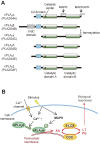Lipoquality control by phospholipase A2 enzymes
- PMID: 29129849
- PMCID: PMC5743847
- DOI: 10.2183/pjab.93.043
Lipoquality control by phospholipase A2 enzymes
Abstract
The phospholipase A2 (PLA2) family comprises a group of lipolytic enzymes that typically hydrolyze the sn-2 position of glycerophospholipids to give rise to fatty acids and lysophospholipids. The mammalian genome encodes more than 50 PLA2s or related enzymes, which are classified into several subfamilies on the basis of their structures and functions. From a general viewpoint, the PLA2 family has mainly been implicated in signal transduction, producing bioactive lipid mediators derived from fatty acids and lysophospholipids. Recent evidence indicates that PLA2s also contribute to phospholipid remodeling for membrane homeostasis or energy production for fatty acid β-oxidation. Accordingly, PLA2 enzymes can be regarded as one of the key regulators of the quality of lipids, which I herein refer to as lipoquality. Disturbance of PLA2-regulated lipoquality hampers tissue and cellular homeostasis and can be linked to various diseases. Here I overview the current state of understanding of the classification, enzymatic properties, and physiological functions of the PLA2 family.
Keywords: fatty acid; lipid; lipidomics; membrane; phospholipase; phospholipid.
Figures








Similar articles
-
Novel functions of phospholipase A2s: Overview.Biochim Biophys Acta Mol Cell Biol Lipids. 2019 Jun;1864(6):763-765. doi: 10.1016/j.bbalip.2019.02.005. Epub 2019 Feb 13. Biochim Biophys Acta Mol Cell Biol Lipids. 2019. PMID: 30769093
-
The phospholipase A2 superfamily as a central hub of bioactive lipids and beyond.Pharmacol Ther. 2023 Apr;244:108382. doi: 10.1016/j.pharmthera.2023.108382. Epub 2023 Mar 12. Pharmacol Ther. 2023. PMID: 36918102 Review.
-
Updating Phospholipase A2 Biology.Biomolecules. 2020 Oct 19;10(10):1457. doi: 10.3390/biom10101457. Biomolecules. 2020. PMID: 33086624 Free PMC article. Review.
-
Membrane Association Allosterically Regulates Phospholipase A2 Enzymes and Their Specificity.Acc Chem Res. 2022 Dec 6;55(23):3303-3311. doi: 10.1021/acs.accounts.2c00497. Epub 2022 Oct 31. Acc Chem Res. 2022. PMID: 36315840 Free PMC article.
-
[Diversity of phospholipases A2 and their functions].C R Seances Soc Biol Fil. 1996;190(4):409-16. C R Seances Soc Biol Fil. 1996. PMID: 8952891 Review. French.
Cited by
-
Metabolomic Analysis Reveals the Effect of Insecticide Chlorpyrifos on Rice Plant Metabolism.Metabolites. 2022 Dec 19;12(12):1289. doi: 10.3390/metabo12121289. Metabolites. 2022. PMID: 36557326 Free PMC article.
-
Group IID, IIE, IIF and III secreted phospholipase A2s.Biochim Biophys Acta Mol Cell Biol Lipids. 2019 Jun;1864(6):803-818. doi: 10.1016/j.bbalip.2018.08.014. Epub 2018 Aug 31. Biochim Biophys Acta Mol Cell Biol Lipids. 2019. PMID: 30905347 Free PMC article. Review.
-
Enzyme-Assisted Synthesis of High-Purity, Chain-Deuterated 1-Palmitoyl-2-oleoyl-sn-glycero-3-phosphocholine.ACS Omega. 2020 Aug 26;5(35):22395-22401. doi: 10.1021/acsomega.0c02823. eCollection 2020 Sep 8. ACS Omega. 2020. PMID: 32923797 Free PMC article.
-
Antimalarial Activity of Human Group IIA Secreted Phospholipase A2 in Relation to Enzymatic Hydrolysis of Oxidized Lipoproteins.Infect Immun. 2019 Oct 18;87(11):e00556-19. doi: 10.1128/IAI.00556-19. Print 2019 Nov. Infect Immun. 2019. PMID: 31405958 Free PMC article.
-
Porcine liver decomposition product-derived lysophospholipids promote microglial activation in vitro.Sci Rep. 2020 Feb 28;10(1):3748. doi: 10.1038/s41598-020-60781-1. Sci Rep. 2020. PMID: 32111938 Free PMC article.
References
-
- Shimizu T. (2009) Lipid mediators in health and disease: enzymes and receptors as therapeutic targets for the regulation of immunity and inflammation. Annu. Rev. Pharmacol. Toxicol. 49, 123–150. - PubMed
-
- Narumiya S., Furuyashiki T. (2011) Fever, inflammation, pain and beyond: prostanoid receptor research during these 25 years. FASEB J. 25, 813–818. - PubMed
-
- Aikawa S., Hashimoto T., Kano K., Aoki J. (2015) Lysophosphatidic acid as a lipid mediator with multiple biological actions. J. Biochem. 157, 81–89. - PubMed
-
- Yamamoto K., Miki Y., Sato H., Murase R., Taketomi Y., Murakami M. (2017) Secreted phospholipase A2 specificity on natural membrane phospholipids. Methods Enzymol. 583, 101–117. - PubMed
Publication types
MeSH terms
Substances
LinkOut - more resources
Full Text Sources
Other Literature Sources

